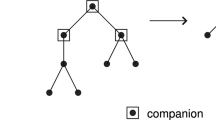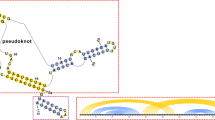Abstract
In this paper, we analyze the length spectrum of rainbows in RNA secondary structures. A rainbow in a secondary structure is a maximal arc with respect to the partial order induced by nesting. We show that there is a significant gap in this length spectrum. We shall prove that there asymptotically almost surely exists a unique longest rainbow of length at least \(n-O(n^{1/2})\) and that with high probability any other rainbow has finite length. We show that the distribution of the length of the longest rainbow converges to a discrete limit law and that, for finite k, the distribution of rainbows of length k becomes for large n a negative binomial distribution. We then put the results of this paper into context, comparing the analytical results with those observed in RNA minimum free energy structures, biological RNA structures and relate our findings to the sparsification of folding algorithms.












Similar content being viewed by others
References
Backofen R, Tsur D, Zakov S, Ziv-Ukelson M (2011) Sparse RNA folding: time and space efficient algorithms. J Discrete Algorithms 9(1):12–31
Barrett C, Li T, Reidys C (2016) RNA secondary structures having a compatible sequence of certain nucleotide ratios. J Comput Biol 23(11):857–873
Barrett C, Huang F, Reidys C (2017) Sequence-structure relations of biopolymers. Bioinformatics 33(3):382–389
Berman H, Westbrook J, Feng Z et al (2000) The protein data bank. Nucl Acids Res 28:235–242
Byun Y, Han K (2009) PseudoViewer3: generating planar drawings of large-scale RNA structures with pseudoknots. Bioinformatics 25(11):1435–1437
Cannone J, Subramanian S, Schnare M et al (2002) The comparative RNA Web (CRW) site: an online database of comparative sequence and structure information for ribosomal, intron, and other RNAs. BMC Bioinform 3:2
Clote P, Ponty Y, Steyaert J (2012) Expected distance between terminal nucleotides of RNA secondary structures. J Math Biol 65(3):581–599
Eddy S (2001) Non-coding RNA genes and the modern RNA world. Nat Rev Genet 2(12):919–929
Flajolet P, Sedgewick R (2009) Analytic combinatorics. Cambridge University Press, New York
Graham R, Knuth D, Patashnik O (1994) Concrete mathematics: a foundation for computer science. Addison-Wesley Professional, Reading
Han H, Reidys C (2012) The \(5^{\prime }\)-\(3^{\prime }\) distance of RNA secondary structures. J Comput Biol 19(7):868–878
Hofacker I, Fontana W, Stadler P, Bonhoeffer L, Tacker M, Schuster P (1994) Fast folding and comparison of RNA secondary structures. Chem Mon 125(2):167–188
Hofacker I, Schuster P, Stadler P (1998) Combinatorics of RNA secondary structures. Discrete Appl Math 88(1–3):207–237
Howell J, Smith T, Waterman M (1980) Computation of generating functions for biological molecules. SIAM J Appl Math 39(1):119–133
Huang F, Reidys C (2012) On the combinatorics of sparsification. Algorithms Mol Biol 7(1):1–15
Hunter C, Sanders J (1990) The nature of \(\pi \)-\(\pi \) interactions. J Am Chem Soc 112(14):5525–5534
Jin E, Reidys C (2010) Irreducibility in RNA structures. Bull Math Biol 72:375–399
Jin E, Reidys C (2010) On the decomposition of \(k\)-noncrossing RNA structures. Adv Appl Math 44:53–70
Kim S, Sussman J, Suddath F et al (1974) The general structure of transfer RNA molecules. Proc Natl Acad Sci USA 71(12):4970–4974
Kruger K, Grabowski P, Zaug A, Sands J, Gottschling D, Cech T (1982) Self-splicing RNA: autoexcision and autocyclization of the ribosomal RNA intervening sequence of tetrahymena. Cell 31(1):147–157
Lorenz R, Bernhart S, Höner zu Siederdissen C, Tafer H, Flamm C, Stadler P, Hofacker I (2011) ViennaRNA Package 2.0. Algorithms Mol Biol 6:26
McCarthy B, Holland J (1965) Denatured DNA as a direct template for in vitro protein synthesis. Pro Natl Acad Sci USA 54(3):880–886
Penner R, Waterman M (1993) Spaces of RNA secondary structures. Adv Math 217:31–49
Robart A, Chan R, Peters J, Rajashankar K, Toor N (2014) Crystal structure of a eukaryotic group II intron lariat. Nature 514(7521):193–197
Robertus J, Ladner J, Finch J, Rhodes D, Brown R, Clark B, Klug A (1974) Structure of yeast phenylalanine tRNA at 3 \(\mathring{A}\) resolution. Nature 250(5467):546–551
Salari R, Möhl M, Will S, Sahinalp S, Backofen R (2010) Time and space efficient RNA–RNA interaction prediction via sparse folding. In: Berger B (ed) Research in computational molecular biology, No. 6044 in Lecture Notes in Computer Science. Springer, Berlin, Heidelberg, pp 473–490
Schmitt W, Waterman M (1994) Linear trees and RNA secondary structure. Discrete Appl Math 51:317–323
Smith T, Waterman M (1978) RNA secondary structure. Math Biol 42:31–49
Šponer J, Leszczynski J, Hobza P (2001) Electronic properties, hydrogen bonding, stacking, and cation binding of DNA and RNA bases. Biopolymers 61(1):3–31
Šponer J, Sponer J, Mládek A, Jurečka P, Banáš P, Otyepka M (2013) Nature and magnitude of aromatic base stacking in DNA and RNA: quantum chemistry, molecular mechanics, and experiment. Biopolymers 99(12):978–988
Stein P, Waterman M (1979) On some new sequences generalizing the Catalan and Motzkin numbers. Discrete Math 26(3):261–272
Waterman M (1978) Secondary structure of single-stranded nucleic acids. In: Rota GC (ed) Studies on foundations and combinatorics, Advances in Mathematics Supplementary Studies, vol 1. Academic Press, New York, pp 167–212
Waterman M (1979) Combinatorics of RNA Hairpins and Cloverleaves. Stud Appl Math 60(2):91–98
Waterman M, Smith T (1986) Rapid dynamic programming algorithms for RNA secondary structure. Adv Appl Math 7(4):455–464
Wexler Y, Zilberstein C, Ziv-Ukelson M (2007) A study of accessible motifs and RNA folding complexity. J Comput Biol 14(6):856–872
Woese C, Magrum L, Gupta R, Siegel R, Stahl D, Kop J, Crawford N, Brosius J, Gutell R, Hogan J, Noller H (1980) Secondary structure model for bacterial 16S ribosomal RNA: phylogenetic, enzymatic and chemical evidence. Nucl Acids Res 8(10):2275–2293
Yoffe A, Prinsen P, Gelbart W, Ben-Shaul A (2011) The ends of a large RNA molecule are necessarily close. Nucl Acids Res 39(1):292–299
Zuker M (1989) On finding all suboptimal foldings of an RNA molecule. Science 244(4900):48–52
Zuker M, Sankoff D (1984) RNA secondary structures and their prediction. Bull Math Biol 46(4):591–621
Acknowledgements
We would like to thank the reviewers for their comments and suggestions and specifically for pointing out a gap in the proof of Lemma 1. We gratefully acknowledge the help of Kevin Shinpaugh and the computational support team at BI. Many thanks to Christopher L. Barrett and Henning Mortveit for discussions. The second author is a Thermo Fisher Scientific Fellow in Advanced Systems for Information Biology and acknowledges their support of this work.
Author information
Authors and Affiliations
Corresponding author
Rights and permissions
About this article
Cite this article
Li, T.J.X., Reidys, C.M. The Rainbow Spectrum of RNA Secondary Structures. Bull Math Biol 80, 1514–1538 (2018). https://doi.org/10.1007/s11538-018-0411-9
Received:
Accepted:
Published:
Issue Date:
DOI: https://doi.org/10.1007/s11538-018-0411-9




